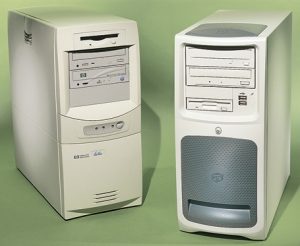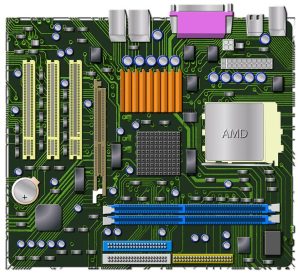Who is the Heart of Computer?
While the heart is a powerful metaphor, pinpointing a single “heart” of a computer gets tricky. Different components play crucial roles:
- CPU (Central Processing Unit): Often called the “brain,” it executes instructions and performs calculations, vital for processing information.
- RAM (Random Access Memory): Holds temporary data the CPU needs instantly, acting like working memory, essential for smooth operation.
- Motherboard: Connects all components, acting as the central communication hub, ensuring everything works together.
Historical Perspective
The journey of computing can be traced back to its humble beginnings, marked by the advent of mechanical calculators and punch card systems. However, it was not until the mid-20th century that the concept of a modern CPU began to take shape. With pioneers like Alan Turing and John von Neumann laying the groundwork, the first electronic computers emerged, paving the way for the development of CPUs as we know them today. Also, read about the Brains of the Computer
Definition and Functionality
At its core, the CPU serves as the primary processing unit of a computer, responsible for executing instructions and performing calculations. Acting as the brain of the system, it interprets and carries out tasks instructed by software programs, thereby enabling the seamless operation of various applications and processes.

Components of a CPU
Within the intricate architecture of a CPU lie several key components, each playing a vital role in its overall functionality. The Arithmetic Logic Unit (ALU) handles mathematical and logical operations, while the Control Unit coordinates the flow of data within the CPU. Additionally, registers and cache memory facilitate swift data access and retrieval, optimizing performance.
Types of CPUs
CPUs come in various forms, ranging from single-core processors to multi-core behemoths. Single-core CPUs execute tasks sequentially, while multi-core processors leverage parallel processing to enhance performance. Each type offers distinct advantages and caters to specific computing needs, whether it be multitasking or high-performance computing.
Importance in Computing
The significance of the CPU cannot be overstated, as it serves as the linchpin of all computational activities. From simple calculations to complex simulations, the CPU orchestrates the execution of instructions, ensuring the smooth functioning of the entire system. Its role in processing data and executing commands makes it indispensable in modern computing environments. For more interesting information visit our website techxwebs.com
Relationship with Other Components
Despite its central role, the CPU does not operate in isolation but rather interacts closely with other hardware components. From communicating with RAM to coordinating with the motherboard, efficient data exchange is essential for optimal performance. Thus, the interplay between the CPU and other components forms the backbone of a cohesive computing ecosystem.
Performance Metrics
Several factors influence CPU performance, including clock speed, cache size, and the number of cores. Higher clock speeds result in faster processing, while larger cache sizes enable quicker data retrieval. Benchmark tests provide valuable insights into a CPU’s capabilities, aiding users in selecting the most suitable option for their needs.
Advancements in CPU Technology
The field of CPU technology is marked by continuous innovation, with manufacturers constantly pushing the boundaries of performance and efficiency. From the introduction of advanced microarchitectures to the integration of artificial intelligence capabilities, recent years have witnessed remarkable advancements in CPU design. These developments have not only bolstered computational power but also paved the way for groundbreaking applications in various domains.

Challenges and Limitations
Despite its progress, CPU technology is not without its challenges. Issues such as power consumption and heat dissipation pose significant hurdles in the quest for higher performance. Additionally, the physical limitations of silicon-based transistors impose constraints on further miniaturization, prompting researchers to explore alternative materials and architectures.
Future Trends
Looking ahead, the future of CPU technology holds promise and potential. Emerging trends such as quantum computing and neuromorphic architectures offer glimpses into a new era of computing, characterized by unprecedented speed and efficiency. As researchers continue to push the boundaries of innovation, the landscape of CPU technology is poised for transformative advancements.
Applications
The applications of CPU technology span across various industries, ranging from consumer electronics to scientific research. From powering smartphones and laptops to driving supercomputers and data centers, CPUs play a pivotal role in shaping our digital world. Their versatility and performance make them indispensable in diverse fields, driving innovation and progress.
Educational Resources
For those eager to delve deeper into the realm of CPU technology, numerous educational resources are available. Online courses, books, and tutorials offer valuable insights into the intricacies of computer hardware, empowering enthusiasts and professionals alike to expand their knowledge and skills.
Conclusion
In conclusion, the CPU stands as the heart of a computer, driving its functionality and performance. From its humble origins to its transformative impact on modern computing, the CPU embodies the spirit of innovation and progress. As we look toward the future, the evolution of CPU technology promises to shape the trajectory of computing, ushering in an era of unparalleled possibilities and advancements.
FAQs
What is the primary function of the CPU?
The primary function of the CPU is to execute instructions and perform calculations, thereby enabling the operation of software programs and applications.
How does the CPU communicate with other components?
The CPU communicates with other components, such as RAM and the motherboard, through a system of buses and interfaces, facilitating the exchange of data and instructions.
What are some factors affecting CPU performance?
Factors affecting CPU performance include clock speed, cache size, the number of cores, and architectural optimizations.
Can CPUs be upgraded?
In some cases, CPUs can be upgraded by replacing them with newer, more powerful models compatible with the existing hardware infrastructure.
What are some examples of CPU-intensive tasks?
CPU-intensive tasks include video rendering, scientific simulations, 3D modeling, and gaming, which require substantial computational resources for smooth execution.

